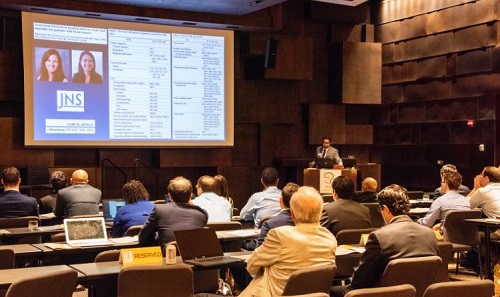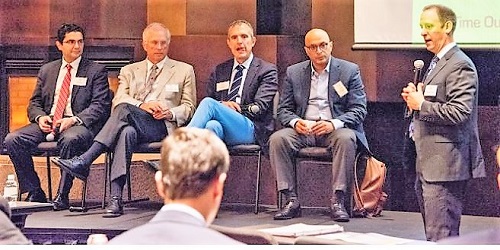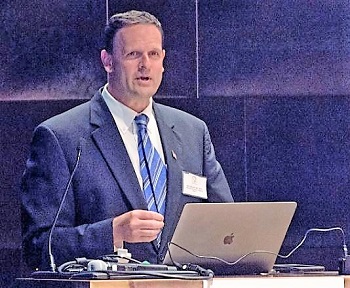Day 1 of NeuroSafe 2018 delivers impressive lineup of neurosurgical quality and safety improvement topics

Neurosurgery Department Head Clark Chen, MD, PhD, kicked off the third annual NeuroSafe symposium, August 2, 2018, at the McNamara Alumni Center on the University of Minnesota campus. Neurosurgeons, scientists, residents and nursing professionals from throughout North America gathered to learn the latest about improving neurosurgical quality and safety.
This year’s symposium is being led by U of M Neurosurgery Department faculty members Matthew Hunt, MD; and Daniel Guillaume, MD, MS. Hunt leads the department’s Residency Program and Guillaume spearheads the department’s quality and safety efforts. They were joined on the NeuroSafe 2018 Planning Committee by Director of Clinic Operations and Faculty Practice/Department Administrator Barb Daiker, RN, PhD; and Administrative Supervisor Claire Graham, and were supported by the U’s Department of Continuing Education.
Oren N. Gottfried, MD, FAANS, of Duke University, provided the morning’s first keynote presentation titled, The Balancing Act: How Do We Maximize Patient Satisfaction While Delivering High-quality Neurosurgical Care? He described Duke’s five-year-old spine and neurosurgery quality program, noting that the university’s Hospital Performances Services and Administration considers it a gold standard, and provides a national example of high performance in quality improvement.
Daiker noted that Gottfried credited real-time physician engagement in Duke’s quality program for measurable patient satisfaction improvement. The gains were achieved through actionable feedback provided to physicians based on both individual and department data about the patient experience.
Data is critical to the success of the program and is gathered from every patient via easy-to-use tools such as a three-question satisfaction survey.Data is critical to the success of the program and is gathered from every patient via easy-to-use tools such as a three-question satisfaction survey. Two of the survey assessment findings highlighted by Gottfried indicated that patients want to be treated well by the individuals with whom they interact most – the nurses – and want to understand their prognosis at discharge.
Another important finding of Duke’s quality program shouldn’t surprise anyone who’s been to a doctor’s office. “Patients often don’t know how long to expect they will be at the clinic,” said Daiker. “The more unclear that expectation is, the lower the patient’s satisfaction.” Increasing communication about wait times and providing refreshments in waiting areas were just a few of Duke’s responses to patient concerns.
Gottfried summarized by noting that
- Duke Neurosurgery and Spine does well compared to national peer group benchmarks in providing quality surgical care to patients as reported by standard metrics
- HCAHPS (Hospital Consumer Assessment of Healthcare Providers and Systems) is more a reflection of total care received at the hospital than of the surgeon
- CGCAHPS (Clinician and Group Assessment of Healthcare Providers and Systems) is more dependent on wait room times than on doctor-specific factors.
A key finding made by another NeuroSafe 2018 keynote presenter is that volume really does matter. Debraj (Raj) Mukherjee, MD, (pictured upper right) of Johns Hopkins University School of Medicine, found that it’s especially important if you’re being treated for glioblastoma, a very aggressive brain cancer.
Mukherjee's analysis of a large dataset showed that brain tumor patients treated at centers with high volumes of such cases fared significantly better than those treated at centers with low case volumes.
Mukherjee's analysis of a large dataset showed that brain tumor patients treated at centers with high volumes of such cases fared significant's better than those treated at centers with low case volumes.
He discussed several data-tracking tools that could help neurosurgery practices gather brain tumor patient data for making better-informed decisions about the quality of their care. He also announced the launch this fall of a brain tumor module in the Quality Outcomes Database, a national registry of neurosurgical patient outcomes.
A round of breakout presentations followed Mukerjee’s keynote and included:
- On Reporting Efforts at Process, Quality and Safety Improvement, Stephen J. Haines, MD, FACS
- Totally Tubular: Prospective Management of Patient Access Devices in the Operating Room, Jeffrey S. Raskin, MD, MS
- Patient and Family Advocate Menu for Participation to Ease Recovery (PAMPER), Orseola Arapi, BS, CCRC
- Does Patient Selection Account for the Perceived Cost Savings in Outpatient Spine Surgery, Mohamad Bydon, MD.

Following lunch, a panel discussion about Incorporating Safety into Day-to-Day Operations was moderated by Hunt (pictured, far right) and featured (left to right) Bydon; Stephen J. Haines, MD; Teodor P. Grantcharov, MD, PhD, FACS; and Ahmed M.T. Raslan, MD.
Grantcharov, who is from the University of Toronto, highlighted a best practice from the airline industry during his keynote titled, Using Data to Enhance Performance and Improve Surgical Safety. He demonstrated how a “black box,” such as the ones in airplanes, can help identify and analyze errors in the operating room.
In his role as Canada Research Chair in Simulation and Surgical Safety, Grantcharov has discovered that – not surprisingly – the human element is the biggest contributor to “categories of threat” in the operating room. He used video to walk through one example of an intraoperative event that highlighted how distractions and interruptions contributed to a negative outcome.
Pediatric neuroscience was the focus of the next keynote speaker, Gerald Grant, MD, FACS, from Stanford University. He posed a question in the title of his presentation: Launch of Quality Assurance Performance Improvement for Pediatric Neurosciences: Are We Making a Difference?
Among the many examples he provided, Grant described a quality improvement program at Stanford Children’s Health/Lucile Packard Children’s Hospital called Realizing Improvement Through Team Empowerment (RITE). The key assumptions upon which RITE is built include:
- When people who do the work are taught and empowered to solve problems, you get better solutions
- Frontline staff owns the process
- Problem-solving capability increases exponentially.

Based on his experience with quality improvement programs, Grant (pictured at left) suggested 10 keys to success:
- People who do the work team up to solve meaningful problems
- Quality improvement (QI) coaches assist teams with methods and tools
- Physician director with QI expertise and organizational authority
- Program director who can orchestrate program and projects
- Supportive department leaders who mentor, protect time, remove barriers
- Weekly project review sessions to ensure project progress
- Applicable, timely, and focused QI education material
- Structured problem-solving methods
- Environment in which projects are done simultaneously to promote team-to-team learning
- Frontline teams given authority to test and develop significant departmental changes.
The day’s presentations wrapped up with another round of breakout sessions:
- Pathway for Omitting ICU Level of Care Following Craniotomy for Resection of Supratentorial Brain Tumors, Chiari Decompression, and Microvascular Decompression Surgery, Jennifer A. Viner, CNRN, MS, NP
- Neurosurgery Surgical Site Infection: One Year of Control Data from a DMAIC Project, Charles R. Watts, MD, PhD
- Use of Physician Performance Platform to Quantify Effects of Durotomy Complications, Adam A. Khan*, MD
- Does Hypothermia in the OR Lead to an Increased Risk for Shunt Infection, Molly E. Hubbard*, MD.
At the end of the first day, Hunt noted, “NeuroSafe is a great opportunity for the neurosurgical community to discuss quality and safety issues that impact our patients and our care systems. It is encouraging to see how engaged our colleagues are in addressing these important issues. I am looking forward to continuing the conversation at NeuroSafe 2019!”
*University of Minnesota neurosurgical resident



